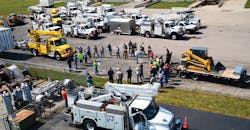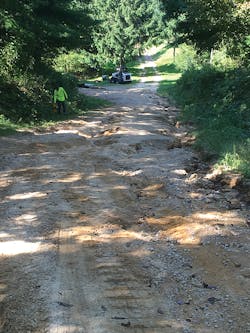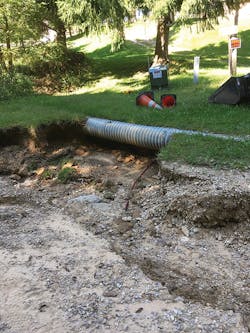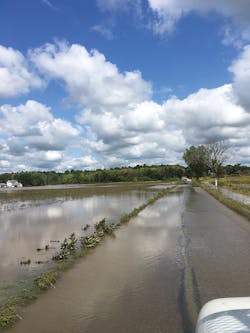Nearly a decade ago, a group of electric distribution cooperatives in Wisconsin, U.S., took on a joint project that, when completed, would become the standard by which all other projects would be measured. It was the perfect example of the sixth cooperative principle: cooperation among cooperatives. The result would prove to be a nationwide-available solution to something not even considered at the time.
In 1999, Dairyland Power Cooperative, a generation and transmission coop, and its member coops formed a group called the mapping symbols standards committee. Initially, the mission of the group was to define a set of standard mapping symbols for use in restoration of power in an emergency (ROPE). The mapping symbols came about because linemen were frustrated and confused by the differences in mapping symbology when working on other distribution systems during ROPE events. There was no standardization. While it was not easy, the committee hammered out a standard and, in the process, realized there might be other projects that could be done together.
Because of this success, the committee has become the go-to group for defining various standard solutions for the entire organization’s 24-member coops. The activity of this group was recognized by the Dairyland Manager’s Association and added in 2010 as a standing subcommittee of the Dairyland policy, procedures and system operations committee. It was rebranded the operations and technology advisory committee (OTAC) — focused on standards — and one of its first projects stemmed from the results of a technology survey in 2010. In the survey, 17 of the 24 member coops indicated they were very interested in implementing an automatic vehicle location (AVL) system within the next five years. The standards committee had a new task at hand: to define a recommended standardized AVL solution for all Dairyland Power coop members.
What About Sharing?
During the request for proposals (RFP) process, the vendor candidates were narrowed down to four. They were invited to LaCrosse, Wisconsin, for further interviews and on-site demonstrations. One of the requirements was the system had to be hosted and centrally managed by Dairyland Power’s information technology (IT) staff. It should be noted the standards committee comprises members from various departments of each of the member coops, including operations, engineering, accounting, telecommunications and IT, to name a few. This mix turned out to be one of the greatest assets of the entire project.
During one of the on-site demos, in the final stages of the RFP phase, one of the IT members asked the question, “Will we be able to share vehicles between cooperatives?” That question had never been asked before and only one vendor, Clevest Solutions, was able to say, “Yes, I think we can make that work.” The idea of an AVL solution for mutual-aid events was born.
Because Clevest Solutions was the only vendor that could provide the sharing of live AVL data between coop systems, among other factors, it was chosen by the standards committee as the standard AVL solution for Dairyland Power member coops. This recommendation by the committee ultimately was adopted by the Dairyland Manager’s Association.
Over the course of the next few years, 16 of the 24 Dairyland Power member coops have implemented Clevest as their AVL solution. Every one of these members can share AVL assets with and borrow them from each other. The term mutual aid is a well-known phrase in the electric industry. In times of need, coops will lend a helping hand by sending crews and vehicles to neighboring coops to help get power restored for their members. For the Dairyland Power member coops, this mutual aid is classified as a ROPE event and is invaluable for coops that have been devastated by a tornado, ice storm and other emergency events.
Though it had never been done before, Clevest Solutions designed a system that, when needed in a ROPE situation, coops answering the call for assistance from another storm-damaged coop can selectively offer to share their AVL data (vehicles) with the system of the coop needing assistance. By doing so, the receiving system now can see the lending coop’s shared vehicles on its AVL system map. A primary benefit of this AVL solution is improved crew safety. With all the activity of a major storm restoration event, there is added concern in ensuring crews are not dispatched into areas currently being restored by other crews and they are not endangering each other.
Giving dispatchers visibility to these borrowed crews on their mapping system greatly improves the safety of all crews. They can be safely guided to restoration work and kept clear of potentially unsafe areas. Not only can dispatchers see them, but all the data associated with those vehicles is recorded. This greatly improves the tracking of these assets (for example, for mileage reimbursement and post-incident reports), just as if the vehicle was owned by the borrowing coop. This easy reporting and accounting capability are appreciated greatly by the coop’s accounting department after the distribution system is rebuilt and every member has power restored.
Examples of Success
Coming together as a group and defining this standard resulted in a few additional benefits:
- Distribution coop savings in the following ways:
- First-year cost savings of US$40,210/coop
- $1 million-plus combined savings on initial equipment costs and first-year fees
- Annual recurring cost savings of $3100/coop
- Streamlined dispatch logistics, especially in ROPE or mutual-aid events
- IT services and hosting at Dairyland Power, reducing workload as well as providing consistent maintenance efforts, upgrades and one point of contact for resolving issues
- Breadcrumb reports providing vehicle location data in the event of a complaint or an issue
- Mileage reports providing documentation for accounting and off-road tax reporting.
Over the last few years, member coops have experienced weather-related disasters that required the use of the ROPE procedures. In one recent event during the summer of 2018, Oakdale Electric Cooperative in west central Wisconsin was the victim of major flooding in its territory. Flooding was so severe it even exposed underground electrical lines in some areas. Several days of severe weather and long hours of hard work had stretched the coop’s crews to the breaking point and help was needed badly.
That is when the ROPE call went out. Coordinated by Dairyland Power, the ROPE event was announced to neighboring cooperatives. Crews, equipment and materials were dispatched and AVL assets were shared with Oakdale Electric’s AVL system. Having the ability to see the locations of those shared assets enabled Oakdale Electric’s dispatchers to efficiently and, more importantly, safely manage all those crews in the field. Because this primarily was a flooding event, Oakdale Electric’s dispatchers and crews knew certain areas were unsafe to travel. However, borrowed crews were not familiar with the territory and unsafe areas. Having AVL visibility at Oakdale dispatchers’ fingertips gave them the ability to guide those crews safely and keep them out of dangerous areas.
The AVL solution also saved a lot of time by reducing radio traffic, because location information was not being broadcast back and forth over the air. This made dispatching more efficient, which ultimately resulted in power being restored much faster than it would have been without the AVL solution. Oakdale Electric estimated the power was restored fully 12 hours to 24 hours faster than it would have been without the aid and the ability to share AVL assets. This is just one example of how the solution works for Dairyland Power member coops, but there are many more.
In early April 2019, a widespread snowstorm with high winds, heavy snow and ice moved across the Midwest. One member distribution coop, located in southwest Minnesota, had nearly 50% of its members without power and more than 650 power poles on the ground. Crews were sent from coops all over Minnesota and neighboring states to help rebuild the distribution system and restore power. At the peak of the rebuilding efforts, approximately 150 linemen were on the ground.
Located in west central Wisconsin, Pierce Pepin Cooperative Services sent a two-man crew in a bucket truck to assist with the restoration and shared the bucket truck with this Minnesota coop as part of the ROPE procedure. Oakdale Electric also was part of the response with two two-man crews in a bucket truck and digger truck. With the help of the AVL sharing capabilities, power was restored to 100% of the members days before it was estimated it would be completed.
Worker Location App
Using an AVL system in a mutual-aid event is talked about more and more, gaining momentum in the industry. Clevest Solutions uses this capability or functionality as part of its marketing materials today. During Hurricane Irma’s approach on Florida, U.S., Clevest Solutions was contacted about a need by one of the electric utilities in the path of the hurricane and developed the worker location app. When the app is loaded on a worker’s smartphone or tablet, the worker’s location can be displayed on a utility’s mapping system or outage management system (OMS). This concept went from idea to execution in 72 hours.
As soon as a contractor or worker downloaded the app and turned it on, they were instantly located on the utility’s dispatch maps. There also was a national mutual-aid response to Hurricane Irma with coops sending equipment and crews from states all over, including a large contingent from Wisconsin. Again, Pierce Pepin responded by sending a bucket truck and two-man crew, and even though it could not share the truck from an AVL standpoint with the requesting coop in Florida (for various reasons), it was able to track the vehicle as the caravan made its way across the U.S. on the way to Florida.
Oakdale Electric also responded with a bucket truck, digger truck and four journeyman linemen, bringing the total response from Wisconsin to 47 individuals from 18 Wisconsin coops. The Florida coop this group was heading down to assist had 170,000 member customers out of power. While Oakdale Electric was not able share the vehicles from an AVL standpoint with the coop in Florida, this event at least ramped up discussions and even some work on a national AVL sharing solution. There are many hurdles still to overcome in achieving a working solution.
Another feature of the worker location app is the control, which is totally on the end user’s side as the user can turn it on or off depending on their work status. The advantages of this type of system are plain to see and likely will be an electric industry standard in the years to come and for other industries, as well. The bottom line is working as a team, whether internally with one organization or among several organizations, has great rewards on many different levels. This goes back again to the sixth principle: cooperation among cooperatives.
For more information:
Clevest Solutions | www.clevest.com
Dairyland Power | www.dairylandpower.com
Oakdale Electric | www.oakdalerec.com
Pierce Pepin Cooperative Services | www.piercepepin.coop
About the Author
Chad Schauf
Chad Schauf, IT director, began working for Oakdale Electric Cooperative as an information technology (IT) consultant in the mid-1990s and was its primary consultant for several years until the utility decided it needed a full-time IT person. He became the utility’s information systems specialist in June 2000.
Jeff Olson
Jeff Olson is vice president, engineering of Pierce Pepin Cooperative Services. He holds a bachelor’s degree in agricultural engineering technology and a master’s degree in computer information systems. Olson joined the coop in 1990. He serves as chair of the Dairyland Power operations and technology advisory committee.




